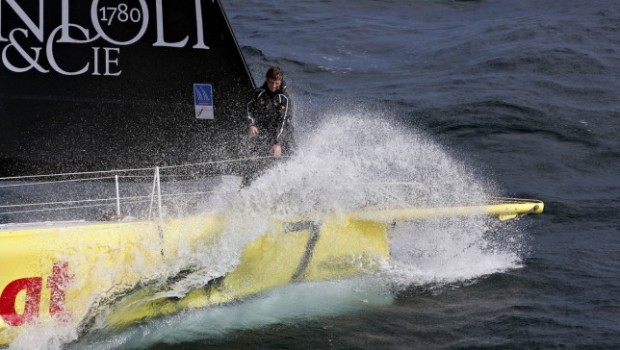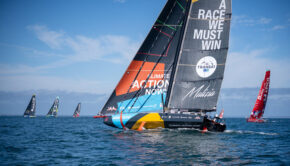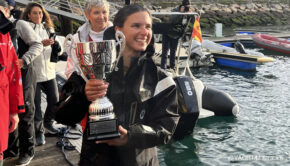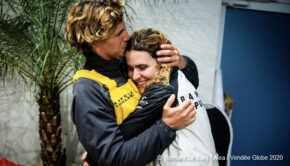Racing around the world with foils
Published on August 19th, 2014
Since the last America’s Cup, foils have been the focus of much attention in the world of sailing. These appendages take the weight off the boat, improving their performance, and in the case of multihulls allow them to fly. In the IMOCA class, which is in charge of the Open 60 monohull for the singlehanded non-stop Vendée Globe race, they recently established its new class rules following much debate around this question: should foils be banned?
In the end, it has been decided that the rules should not be changed, thus leaving the door open for these rather ‘exotic’ appendages to be allowed. Here the President of the IMOCA, Jean Kerhoas is interviewed on the Vendee Globe website:
 Jean Kerhoas, can you explain to us how the IMOCA came to a decision concerning the use of foils?
Jean Kerhoas, can you explain to us how the IMOCA came to a decision concerning the use of foils?
“To understand this matter, you have to look at the major decisions concerning the IMOCA rules currently in force and that everyone now knows: the mast and canting keel are one design features, while the hull and appendages remain open. It’s true that within the class there has been some discussion about this question. Without revealing any secrets, some teams applied pressure stressing the need to strengthen still further the mast to take into account the development of more powerful hulls and the possibility of using “exotic” appendages, including foils.
“Opinions diverged with some pleading in favour of more changes to the rules (with a ban on foils for example, editor’s note) with others arguing that the recently modified rules should not be changed again after all the previous lengthy discussions. In the end, the IMOCA board decided not to modify the class rules. This decision is quite simple. No change to the rules means that everything that was allowed remains allowed.”
Just to be clear, that means that “exotic” appendages, such as foils, are a possibility for the new boats?
“In theory, yes. It really means that the choice of appendage remains open (or in other words that designers and studies can continue to work in this area, editor’s note). But that doesn’t mean that any old thing is possible. Everything on the boat has a bearing other elements and as nothing is being changed, what they come up with still has to respect the use of the one-design mast and keel. Those are designed for a certain power (30 tonnes/metre for the mast). Respecting those parameters limits the possibilities. But it is true that “exotic” appendages are not banned.”
If we understand you correctly, that means that what was allowed remains so?
“Exactly. Rules can’t be changed willy-nilly or during the competition, if you prefer. If we made modifications to class rules, we would have to convene the IMOCA members to a general assembly. There were discussions between all those involved or affected by this question – sailors, designers, sponsors – and we came to the decision not to modify the rules at an IMOCA class board meeting.”
We shall probably find out more when the new boats are launched in 2015?
“Yes. Today it is too soon to draw any conclusions or make any projections and I am unable to say whether or not there will be foils on the IMOCA boats competing in the 2016 Vendée Globe. We will discover what has been achieved in terms of performance – following on from what they have come up with – when the new boats first do battle in the 2015 Transat Jacques Vabre.”
As for the designers, they are keeping quiet…
The designers we contacted did not wish to say anything for the moment about this matter. We do, however, know that if we look at things in general terms that they are interested in the question of the overall dynamic stability of the boats and the use of appendages does offer lift, taking the weight off the boats and enhancing their performance. We can therefore look forward to some very interesting technological innovations concerning the appendages, when the boats are finally launched, with several planned for early 2015.
However, we should not expect to see flying monohulls like the multihulls in the America’s Cup. Firstly, because sailing around the world single-handed is very different from sailing around buoys in a bay for a few hours. But more importantly, because unlike multihulls, monohulls have three and a half tonnes of ballast in the keel bulb, 4m50 under the water… meaning it’s not going to be easy to get them to fly, even if the current keels are designed to offer some lift.
Nevertheless, some surprise solutions may appear, such as the use of a fixed keel, as planned by the designer Juan Kouyoumdjian, which in his opinion would mean that the question of foils can be tackled in a different way. But that is just one possibility among others and the VPLP-Verdier design teams (who are behind the four boats due to be launched next year) are not ones to ‘drag’ their feet (no pun intended).









 We’ll keep your information safe.
We’ll keep your information safe.